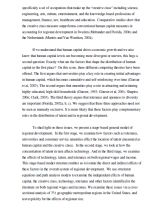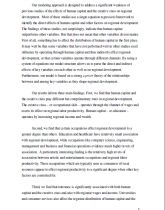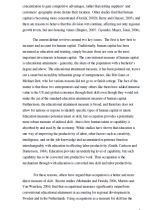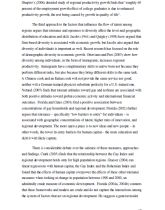Hledej
Zobraz:
Univerzity
Kategorie
Rozšířené vyhledávání
12 662
projektů
Home » Projekt » Inside the Black Box of Regional Development: Human Capital, the Creative Class and Tolerance
Inside the Black Box of Regional Development: Human Capital, the Creative Class and Tolerance
| Přípona |
Typ projekt |
Stažené 0 x |
| Velikost 1,0 MB |
Jazyk anglický |
ID projektu 2930 |
| Poslední úprava 27.03.2014 |
Zobrazeno 1 743 x |
Autor: eliseus |
 Sdílej na Facebooku
Sdílej na Facebooku |
||
| Detaily projektu | ||
- Cena:
2 Kreditů - kvalita:
91,1% -
Stáhni
- Přidej na srovnání
- Univerzita:Univerzita Tomáše Bati ve Zlíně
- Fakulta:Fakulta managementu a ekonomiky
- Kategorie:Ekonomika » Management
- Předmět:Management
- Studijní obor:-
- Ročník:-
- Formát:PDF dokument (.pdf)
- Rozsah A4:48 stran
What really drives economic development? It is complex question, so it is not
surprising that lots of opinions and answers have been offered. If you ask the typical
person on the street, they will tell you the key is jobs. Seems to jibe with common
sense: When a place attracts new jobs, more wealth and other good things follow.
This conventional wisdom is the backbone of a good deal of economic development
policy, as economic developers scramble to lure companies to their towns. Others say
technology is key. Pointing out places like Silicon Valley, they say success lies in a
high-tech cluster of great research universities, abundant venture capital and
entrepreneurial startup companies. But according to current thinking and research in
economics, geography and social science broadly, the underlying driver of economic
development is highly skilled and educated people - what some call talent and what
economists and social scientists frequently refer to as human capital. Places that have
more of it thrive, while those with less stagnate or decline.
surprising that lots of opinions and answers have been offered. If you ask the typical
person on the street, they will tell you the key is jobs. Seems to jibe with common
sense: When a place attracts new jobs, more wealth and other good things follow.
This conventional wisdom is the backbone of a good deal of economic development
policy, as economic developers scramble to lure companies to their towns. Others say
technology is key. Pointing out places like Silicon Valley, they say success lies in a
high-tech cluster of great research universities, abundant venture capital and
entrepreneurial startup companies. But according to current thinking and research in
economics, geography and social science broadly, the underlying driver of economic
development is highly skilled and educated people - what some call talent and what
economists and social scientists frequently refer to as human capital. Places that have
more of it thrive, while those with less stagnate or decline.
Klíčová slova:
Human Capital
Creative Class
Tolerance
Wages
Income
Regional Development
Obsah:
- Abstract
Introduction
Theory and Concepts
Model
Variables
Technology Variables
Methods
Findings
Inside the Black Box of Regional Development
Human Capital
How and Why Occupations Matter to Regional Development
Explaining the Uneven Distribution of Human Capital
Tolerance
References
Zdroje:
- AMABILE, T. (1996) Creativity in Context, Boulder, CO: Westview Press
- ANDERSSON, Å. E. (1985a) Creativity and Regional Development, Papers of the Regional Science Association, 56:5-20.
- ANDERSSON, Å. E. (1985b) Creativity - The Future of Metropolitan Regions, Stockholm: Prisma.
- BARRO, R. J. (1991) Economic Growth in a Cross Section of Countries, Quarterly Journal of Economics, 106(2): 407-443.
- BARRO, R. J. (1997) Determinants of Economic Growth: A Cross-Country Empirical Study, Cambridge, MA: The MIT PressBECKER, G. (1964) Human Capital, New York: Columbia University Press for the National Bureau of Economic Research
- BECKER, G. (1993) Human Capital: A Theoretical and Empirical Analysis, with Special Reference to Education, Chicago: The University Press of Chicago
- BERRY, C. R., GLAESER, E. L. (2005) The Divergence of Human Capital Levels Across Cities, NBER Working Paper No. 11617, September 2005.
- CLARK, T. N., LLOYD, R., WONG, K. K., JAIN, P. (2002) Amenities Drive Urban Growth, Journal of Urban Affairs, 24:5: 493-515.
- CLARK, T. N. (2003) Urban Amenities: Lakes, Opera and Juice Bars Do They Drive Development? In: The City as an Entertainment Machine. Research in Urban Policy, Volume 9: 103-140, Oxford: Elsevier Ltd.
- FELDMAN, M., MARTIN, R. (2004) Jurisdictional Advantage, NBER Working Paper No 10802, September 2004
- FLORIDA, R., GATES, G. (2001) Technology and Tolerance - The Importance of Diversity to High-Technology Growth, Urban Institute, June 01
- FLORIDA, R. (2002a) The Rise of the Creative Class, New York: Basic Books.
- FLORIDA, R. (2002b) The Economic Geography of Talent, Annals of the Association of American Geographers, 92(4): 743-755.
- FLORIDA, R. (2002c) Bohemia and economic geography, Journal of Economic Geography, 2: 55-71.
- FLORIDA, R. (2004a) Revenge of the Squelchers, The Next American City, Issue 5, July



